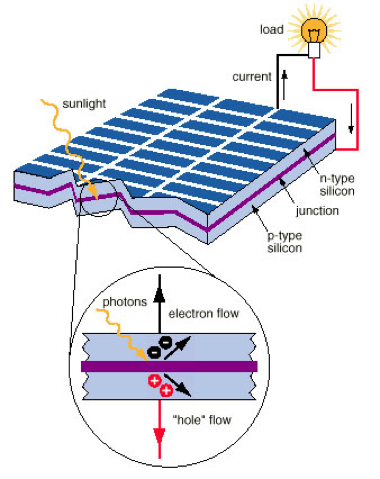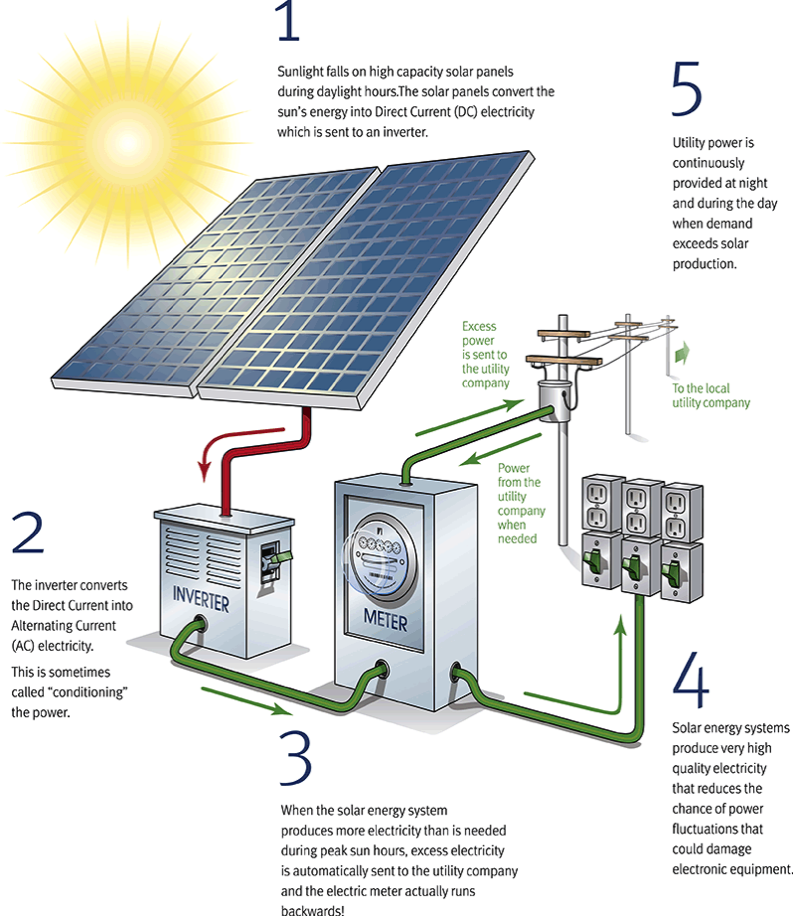Introduction to Solar Electricity
Interested in learning what Solar can do for your business or building?
See how we prepare a digital satellite survey and proposal for your business or building
Request a free initial onsite or satellite survey of your business or building.
Questions about your project? Call Doug Griffin direct at (239) 464-8699 or email doug@solaronefinancial.com
Solar Photovoltaic Basics
Solar cells, also called photovoltaic (PV) cells convert sunlight directly into electricity. PV gets its name from the process of converting light (photons) to electricity (voltage), which is called the PV effect. The PV effect was discovered in 1954, when scientists at Bell Telephone discovered that silicon (an element found in sand) created an electric charge when exposed to sunlight. Soon solar cells were being used to power space satellites and smaller items like calculators and watches. Today, thousands of people power their homes and businesses with individual solar PV systems. Utility companies are also using PV technology for large power stations.
Solar modules used to power homes are typically made from solar cells combined into modules that hold about 60 cells. Utility Grade commercial modules are 72 cells. The modules are mounted at a fixed angle facing south, east, west or flat. Many solar modules, 15 to 20 combined together to create one solar array, or string. For large electric utility or industrial applications, hundreds of solar arrays are interconnected to form a large utility-scale Photovoltaic system.
Traditional solar cells are made from silicon, are usually flat-plate, and generally are the most efficient. Second-generation solar cells are called thin-film solar cells because they are made from amorphous silicon or non silicon materials such as cadmium telluride.
Silicon based systems are the most efficient and have a proven history and more importantly, manufactured at a scale that other PV types will not see for many years.



How It Works
The sun’s photons strike the surface of the solar cell and an electron flow is created in each cell, this is DC electricity.
This electricity flows to the Inverter that converts DC to AC power for use in your business. The inverter, the brains of the system, is also connected to the GRID and your electric system. During the day, the solar array will generate 100% of the building’s electricity needs first, then the excess electricity is pushed out through the “net meter” to the GRID. The net meter credits this excess electricity to your account, you use it later (at night or during cloudy days). The inverter provides web based performance reporting, and service notifications by email to manufacturer service center.
Sunlight falls on high capacity solar modules during daylight hours. The Solar modules convert the sun's energy (photons) into direct current (DC) electricity which is sent to the inverter.
Utility power is continuously provided at night and during the day when demand exceeds solar production.
The inverter converts the Direct Current into Alternating Current (AC) electricity.
Solar energy systems produce very high quality electricity that reduces the chance of power fluctuations that could damage electronic equipment.
When the solar energy system produces more electricity than is needed during peak sun hours, excess electricity is automatically sent to the utility company and the electric meter actually runs in backwards to track the amount of electricity returned.
To the local utility company.
Excess power is sent to the utility company.
Power from the the utility company when needed.
